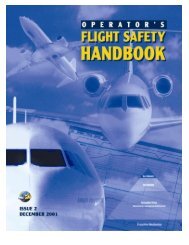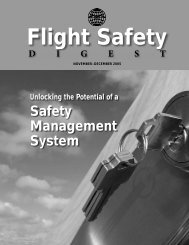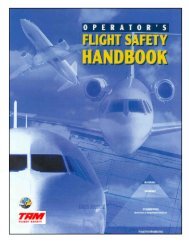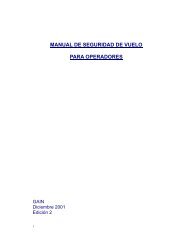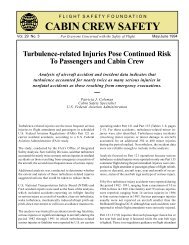Download PDF [10.9 MB] - Flight Safety Foundation
Download PDF [10.9 MB] - Flight Safety Foundation
Download PDF [10.9 MB] - Flight Safety Foundation
You also want an ePaper? Increase the reach of your titles
YUMPU automatically turns print PDFs into web optimized ePapers that Google loves.
German Federal Bureau of Aircraft Accident Investigation (BFU)<br />
Serious Incident in 2008 Prompted German and EASA Analyses<br />
Freezing rain caused a two-hour delay in the Airbus A320’s<br />
departure from Munich, Germany, for a scheduled flight<br />
with 132 passengers and five crewmembers to Hamburg<br />
the afternoon of March 1, 2008.<br />
During cruise, the flight crew received a Hamburg automatic<br />
terminal information system report of winds from 280<br />
degrees at 23 kt, gusting to 37 kt. They planned for — and<br />
later received clearance for — an approach and landing on<br />
Runway 23, which is equipped with an instrument landing<br />
system (ILS) approach, said the report by the German Federal<br />
Bureau of Aircraft Accident Investigation (BFU).<br />
When the crew reported that they were established on<br />
the ILS approach, the airport air traffic controller said that the<br />
wind was from 300 degrees at 33 kt, gusting to 47 kt.<br />
The report said that a decision to go around would have<br />
been reasonable because the controller’s report indicated<br />
that the winds exceeded the maximum demonstrated crosswind<br />
for landing, which was “33 kt, gusting up to 38 kt” and<br />
presented as an operating limitation in the A320 flight crew<br />
operating manual.<br />
The captain asked for the current “go-around rate,” and<br />
the controller replied, “Fifty percent in the last 10 minutes.”<br />
The controller offered to vector the aircraft for a localizer<br />
approach to Runway 33, but the captain replied that they<br />
would attempt to land on Runway 23 first.<br />
maximum<br />
47 kt<br />
268°<br />
323°<br />
FLIGHTSAFETY.ORG | AEROSAFETYWORLD | MAY 2013<br />
Hamburg<br />
Airport<br />
Figure 1<br />
Runway 23<br />
THREATANALYSIS<br />
The crew gained visual contact with the runway at the<br />
outer marker. The copilot, the pilot flying, disengaged the<br />
autopilot and autothrottles about 940 ft above the ground.<br />
She used the wings-level, or crabbed, crosswind-correction<br />
technique until the aircraft crossed the runway threshold<br />
and then applied left rudder and right sidestick to decrab<br />
the aircraft — that is, to align the fuselage with the runway<br />
centerline while countering the right crosswind.<br />
The A320 was in a 4-degree left bank when it touched<br />
down on the left main landing gear and bounced. Although<br />
the copilot applied full-right sidestick and right rudder, the<br />
aircraft unexpectedly rolled into a 23-degree left bank. It<br />
touched down on the left main landing gear again, striking<br />
the left wing tip on the runway, and bounced a second time.<br />
The crew conducted a go-around and landed the aircraft<br />
without further incident on Runway 33. The left wing tip, the<br />
outboard leading-edge slat and slat rail guides were found to<br />
have been slightly damaged during the serious incident, the<br />
report said, but the ground contact was not detected by the<br />
flight crew.<br />
The BFU, in its final report, listed the immediate causes:<br />
“The sudden left wing down attitude was not expected by<br />
the crew during the landing and resulted in contact between<br />
the wing tip and the ground. During the final approach to<br />
land, the tower reported the wind as gusting up to 47 kt, and<br />
the aircraft continued the approach. In view of the maximum<br />
crosswind demonstrated for landing, a go-around would<br />
have been reasonable. System-level causes were: “The terminology<br />
maximum crosswind demonstrated for landing [italics<br />
added] was not defined in the Operating Manual (OM/A)<br />
and in the <strong>Flight</strong> Crew Operating Manual (FCOM), Vol. 3, and<br />
the description given was misleading. The recommended<br />
crosswind landing technique was not clearly described in the<br />
aircraft standard documentation. The limited effect of lateral<br />
control was unknown.”<br />
In the relevant time period, the surface wind at Hamburg<br />
was being measured by German Meteorological Service<br />
anemometers located near the thresholds of Runways 23/33<br />
and 15, and was logged at 10-second intervals. Air traffic controllers<br />
also had data on maximum veer angle and peak wind<br />
speed for the preceding 10 minutes. “In the final 10 minutes<br />
prior to the occurrence, the wind direction varied between<br />
268 degrees (minimum) and 323 degrees (maximum),” the report<br />
said. “In this period, the maximum gust speed recorded<br />
was 47 kt [Figure 1].”<br />
When the controller later gave the crew clearance to land on<br />
Runway 33, the information included wind from 300 degrees at<br />
33 kt gusting to 50 kt (two-minute mean value). Four additional<br />
Continued on p. 42<br />
| 41


![Download PDF [10.9 MB] - Flight Safety Foundation](https://img.yumpu.com/18550968/43/500x640/download-pdf-109-mb-flight-safety-foundation.jpg)

![Download this Issue [PDF 7 MB] - Flight Safety Foundation](https://img.yumpu.com/18859635/1/190x245/download-this-issue-pdf-7-mb-flight-safety-foundation.jpg?quality=85)
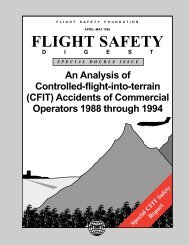
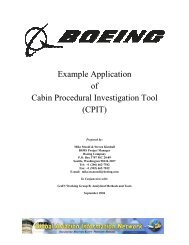
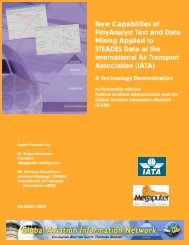
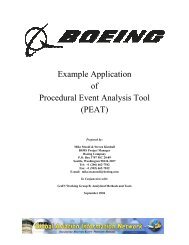
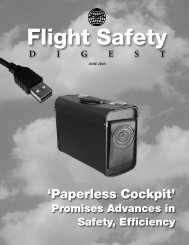
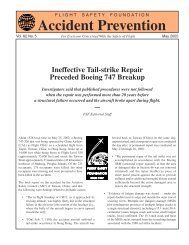
![Download [PDF 8 MB] - Flight Safety Foundation](https://img.yumpu.com/18859366/1/190x245/download-pdf-8-mb-flight-safety-foundation.jpg?quality=85)
